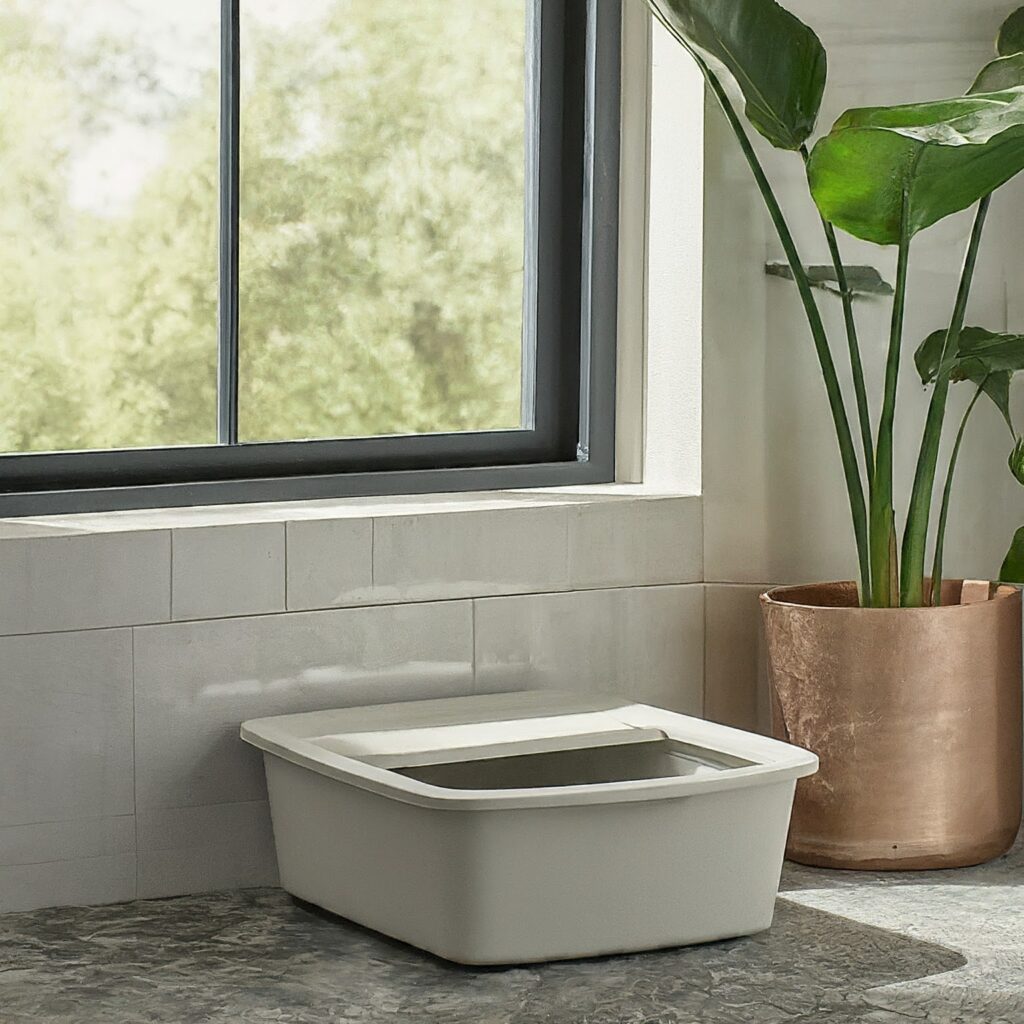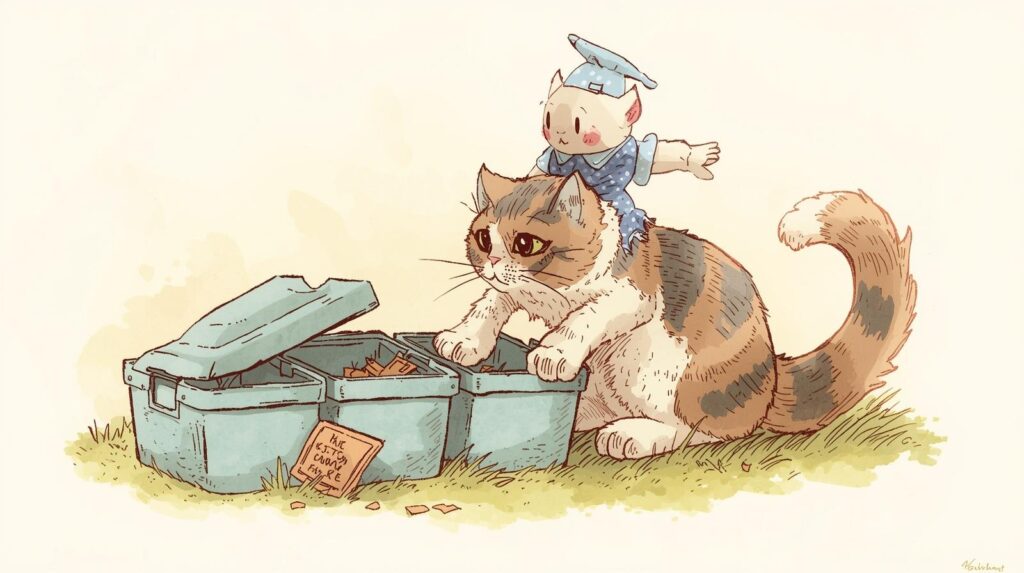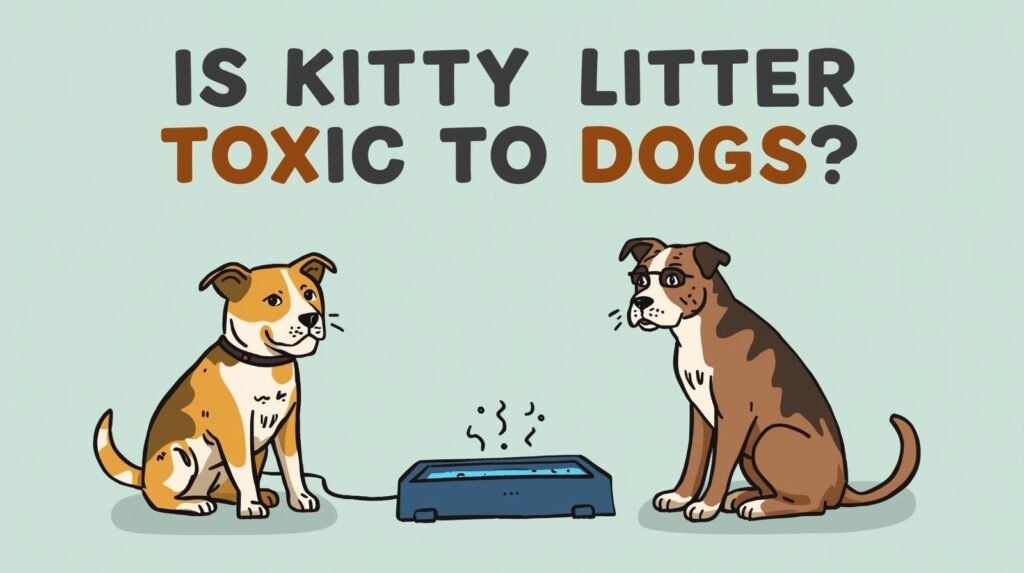
If you’ve ever caught your dog sneaking into the litter box, nose-deep in curiosity, you’re definitely not alone. Many pet parents worry the moment they see their dog sniffing, chewing, or even eating litter — and the first question that comes to mind is safety.
So, is kitty litter toxic to dogs?
The short answer is yes — it can be, depending on the type of litter, the amount eaten, and your dog’s size and health condition. Most cat litters are made for feline digestion, not dogs. When a dog eats litter, it can cause intestinal blockage, dehydration, bacteria exposure from cat faeces, or even chemical irritation if the litter contains fragrance additives or clumping agents. Vets warn that puppies, small breeds, and dogs with sensitive digestion face the highest risk.
The good news? With the right setup, training, and vet-approved safety steps, you can protect both your dog and your cat without stress or constant monitoring. In this guide, we’ll walk through what makes some litters dangerous, which dogs are at higher risk, how to stop the behaviour, and what to do if your dog has already eaten some.
This is your full pet-parent roadmap — practical, science-backed, and easy to follow.
Table of Contents
Can dogs get sick from eating cat litter? (Real Risks Explained by Vets)
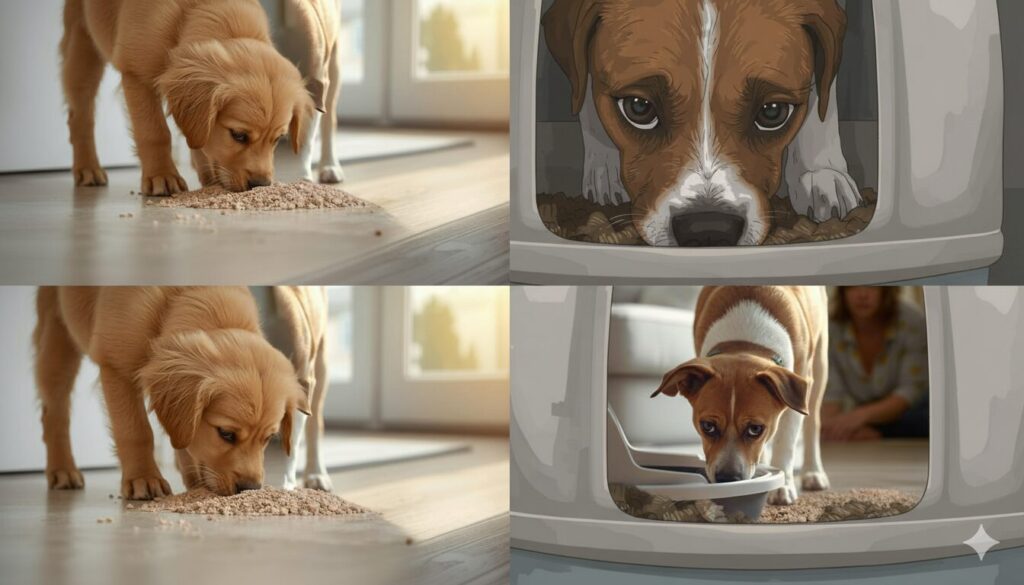
Yes, dogs can get sick from eating cat litter, and the level of danger depends on the type of litter and how much they swallow. Most cat litters are designed to absorb moisture. When it gets inside a dog’s stomach, it begins to swell — which can lead to blockage, dehydration, constipation, or painful digestive issues.
Vets say the highest risk comes from clumping litter, because it expands into a sticky paste inside the intestines. Small-breed dogs and puppies are affected faster since their digestive tracts are narrower. On the other hand, silica crystal litter can irritate the gut lining and sometimes cause vomiting or diarrhoea.
But litter alone isn’t the only problem — cat feces inside the litter can carry bacteria and parasites like Toxoplasma gondii, roundworms, and hookworms. This is why dogs sometimes show symptoms such as:
- Straining during poop
- Swollen or painful abdomen
- Lethargy or loss of appetite
- Vomiting or gagging
- Dry stool or constipation
Even if your dog looks “fine” shortly after eating litter, the risks can appear hours later once swelling or irritation increases. That’s why vets recommend monitoring your dog after any litter ingestion, especially if they are small, old, or have a history of stomach sensitivity.
In multi-pet homes, the danger is not just “gross behaviour” — it’s a genuine health risk that’s often overlooked.
How do I get my dog to stop eating cat litter? (Realistic Home Solutions)
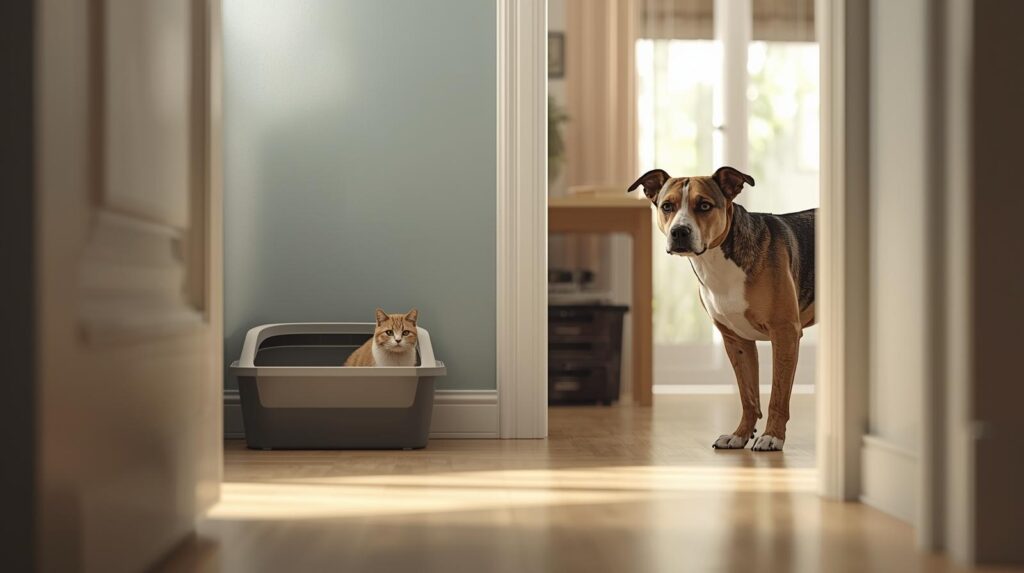
Yes — you can stop this behavior at home with a few smart changes. Dogs are curious eaters, and if the poop smells like food, many will keep going back unless you block access and change the environment.
Below are vet-approved, realistic strategies you can start today:
Block Access to the Litter Box
The most effective solution is prevention.
Simple ways to block access:
- Use a covered litter box with a flap door
- Place the litter box in a cat-only room using a baby gate with a small pet door
- Install a top-entry litter box
- Put the litter box in a higher spot (shelf/cabinet) where only the cat can jump
Switch to a Safer, Less Tempting Litter
Some dog breeds love the scent and texture of litter — especially clumping clay.
Switching to a safer type reduces attraction and danger.
Better alternatives include:
- Paper-based litter
- Pine or wood pellets
- Non-clumping natural litter
- Grass seed litter (fully digestible, but still should be avoided)
These are usually less appealing to dogs because they don’t smell like food.
Scoop More Often (Best Daily Habit)
Dogs mostly eat cat poop because the odor is fresh.
If the litter box stays clean, there is less curiosity.
Best cleaning routine:
- Scoop at least twice a day
- Replace litter weekly
- Wash the tray every 1–2 weeks
- Use an odor-neutralizing enzyme spray (pet-safe)
Give Your Dog More Mental Enrichment
Sometimes the problem is boredom, not hunger.
A mentally bored dog explores more — including the litter box.
Try these interactive enrichments:
- Snuffle mats
- Slow feeders
- Lick mats
- Long-lasting chews
- Puzzle toys
This keeps the dog’s nose and mouth busy somewhere else.
Improve Diet + Add Fiber (Works for Poop-Eaters)
Some dogs eat cat poop because they are missing nutrients or fiber.
Ask your vet about:
- A diet upgrade or higher-quality protein
- Pumpkin (1–2 tsp)
- Psyllium husk (tiny amounts approved by vet)
- Dog-safe probiotics
This reduces cravings for stool (a common behavior called coprophagia).
Use Training “Leave It” + Redirection
Teaching a “leave it” or “off” command works very well with repeat offenders.
Tip:
Reward your dog away from the litter box so they learn what “good behavior” looks like.
Which types of kitty litter are MOST dangerous for dogs?
Not all kitty litters are equally risky. Some just upset the stomach, while others can swell, clump, and block the intestines, which may require emergency surgery in dogs. Below are the most dangerous types, ranked by risk level.
Highest Risk (Vet-Warning Level)
1. Clumping Clay Litter (Bentonite)
This is the #1 most dangerous type for dogs.
Why it’s risky:
- Absorbs moisture and expands up to 15–20x
- Turns into a cement-like blockage inside the stomach or intestines
- Can trap bacteria from cat poop
- Can cause vomiting, dehydration, or intestinal obstruction
Even a small amount can cause harm in small dogs.
2. Crystal / Silica Gel Litter
This type doesn’t clump, but it’s still highly dangerous if eaten.
Why it’s risky:
- Hard to digest
- Can scratch the intestinal lining
- Can cause internal irritation and bleeding
- Risk of choking if larger pieces are swallowed
Some silica-based litters also contain deodorising chemicals that are toxic in large amounts.
3. Scented or Odor-Control Litter
Even if it’s natural, the fragrances and additives can irritate the stomach.
Possible reactions:
- Vomiting
- Drooling
- Diarrhea
- Chemical sensitivity
Dogs with food allergies or sensitive GI tracts react more strongly.
4. Corn, Wheat, or Grain-Based Litters
These are safer than clay, but still risky because dogs may think they’re food.
Potential problems:
- Mold growth (especially aflatoxins → toxic to the liver)
- Bloating occurs if a large amount is eaten
- Encourages repeat eating because of the scent
Safer Options
| Litter Type | Safety Level | Why It’s Safer |
|---|---|---|
| Paper/Pellet litter | Very low risk | Breaks down naturally |
| Pine/Wood pellet litter | Low risk | Less appealing taste |
| Grass seed litter | Digestible, but still should not be eaten | Digestible but still should not be eaten |
Even with safer types, the goal is still prevention, not permission — no litter is “safe” to eat.
What Happens If a Dog Eats Kitty Litter? (Symptoms & When to See a Vet)
When a dog eats kitty litter, the danger depends on how much was eaten, the type of litter, and the size of the dog. The biggest risks are intestinal blockage, bacterial infection (from cat feces), and dehydration.
What Actually Happens Inside the Body
| Stage | What Happens |
|---|---|
| Absorption | Clumping litter swells inside the stomach/intestine |
| Hardening | The litter forms a thick cement-like plug |
| Obstruction | Food and water can’t pass through |
| Infection | Bacteria from poop enters the gut |
| Emergency | Dog may need surgery if blockage is severe |
Symptoms to Watch For
If your dog ate kitty litter and is showing ANY of the following, call your vet:
Early Warning Signs
- Excessive drooling
- Licking lips or swallowing repeatedly
- Mild belly discomfort
- Sudden thirst or dehydration
- Strange gagging or coughing
Digestive Symptoms
- Vomiting (especially thick or grainy texture)
- Diarrhea or very dry, chalky stool
- Loss of appetite
- Straining to poop
Severe or Emergency Signs
These mean “go to the vet NOW”:
- Bloated, swollen, or hard belly
- Weakness or whining in pain
- No poop for 24 hours
- Pale gums
- Collapsing or lying very still
A small dog can get a dangerous blockage after eating just a few tablespoons of clumping litter.
When to See a Vet (Simple Rule)
| Situation | What to Do |
|---|---|
| Small amount + no symptoms | Monitor at home |
| Moderate amount + mild stomach upset | Call your vet for advice |
| Clumping litter + large amount | Vet visit recommended |
| Bloody vomit/poop, swelling, or pain | Emergency clinic immediately |
Home First Aid (Before You Reach the Vet)
- Offer fresh water to help flush
- Check gums (should be pink, not pale)
- Monitor for vomiting or bloating
- Do NOT give oil, milk, or random home remedies
- Do NOT force vomiting (dangerous for clumping litter)
How do I keep my litter box safe from dogs? (Real-world home setups & vet-approved tips)
Keeping a dog away from the litter box is not just about cleanliness — it’s about preventing health problems like GI upset, worms, or intestinal blockage. Below are practical, vet-approved, real-home strategies that actually work.
1. Change The Location (Best First Step)
Dogs follow scent — so distance helps.
Place litter in:
- Laundry room
- Bathroom corner behind a baby gate
- A closet with a cat-only access door
- A low-mounted wall shelf or platform
Avoid
- Open areas (kitchen/hallway)
- Areas near dog feeding spots
2. Use Dog-Proof Entry Systems
| Method | Why It Works |
|---|---|
| Baby gate with cat-door | Cat enters, dog can’t |
| Litter box cabinet | Hidden + odor control |
| Cat flap on a laundry room door | Permanent, low maintenance |
| Covered entry furniture | Decorative + functional |
This keeps your dog out 24/7, not only when you’re watching.
3. Scoop More Often (Less Temptation)
Dogs are attracted most to fresh stools because of the leftover protein content.
Scooping 2–3 times a day drastically reduces interest.
Bonus tip: Adding a litter deodorizer reduces scent cues that draw dogs in.
4. Train a “Leave It” Cue
Behavior correction works long-term.
Quick training script:
When dog approaches litter → say “Leave it” → reward when they turn away.
Use high-value treats so your command becomes stronger than curiosity.
5. Avoid Scented, Strong-Smelling Litter
Ironically, heavily scented litter makes some dogs more curious.
Unscented or natural pellet-based litters create less interest.
6. Physical Barriers That Actually Work (Bullet List)
- Install a cat-height baby gate
- Use top-entry litter boxes
- Put the litter box inside a cabinet
- Use a hallway playpen divider
- Elevate the litter box onto a platform shelf
- Use a covered cabinet with side cat-entry
Vet Insight
Dogs not only eat litter out of curiosity — many do it because the scent mimics a high-protein reward (cat poop contains undigested nutrients). So managing access + mental stimulation together works best.
Why Do Some Dogs Obsessively Eat Cat Poop?
If your dog keeps going back to the litter box again and again, this is not just “bad behavior” — it usually has a Dogs and Kitty Litter: What is the Risk?. Vets call this habit coprophagia, and in dogs, it is far more common than most owners realize.
Here’s what REALLY drives it:
1. Natural Scavenging Instinct
Dogs are biologically wired to search for high-protein scents.
Cat poop contains undigested proteins and fats, so to a dog’s nose, it smells like a food reward, not waste.
2. Nutrient Deficiencies
If a dog isn’t getting enough digestible protein, B vitamins, or digestive enzymes, it may try to “self-correct” by scavenging.
Common deficiencies linked to litter-box eating:
- Poor-quality kibble diet
- Low digestive enzymes
- Gut flora imbalance
- Malabsorption issues
This is why some vets recommend probiotics or enzyme-support supplements as part of the fix.
3. Boredom or Anxiety
Dogs sometimes “forage” when they are:
- Under-stimulated
- Lonely when left alone
- Experiencing separation anxiety
- Lacking mental exercise
This turns litter eating into a stress-relief behavior, similar to pacing or chewing furniture.
4. Territory or Curiosity
Some dogs are simply too curious — especially puppies or high-drive breeds (Labradors, Shepherds, Terriers).
They explore with their mouths, and litter becomes a novel texture + odor combination.
5. Learned Behavior
Even one successful “reward” from the litter box teaches the brain:
This spot = food jackpot.
Dogs build habits FAST.
6. Underlying Medical Conditions
Sometimes compulsive litter eating is a medical red flag.
Possible health issues behind it:
| Condition | Why It Increases Scavenging |
|---|---|
| Parasites | Steal nutrients → dog eats more to compensate |
| Diabetes | Drives hunger |
| Cushing’s disease | Causes food-seeking behavior |
| Malabsorption | Dog craves nutrient-rich waste |
| Pancreatic issues | Poor enzyme breakdown |
If a dog suddenly starts eating litter after never doing it before, vets recommend a stool test + bloodwork.
Vet-Approved products for you
Below are recommended product categories and what to look for.
Baby gate or pet gate with cat-door (or elevated dog-proof barrier)
Litter box cabinet / enclosed litter box furniture
Top-entry litter box or elevated platform box
Dog enrichment toys / slow-feeders / puzzle toys
How to Use Them Together (Vet-Approved Setup)
- Place your litter box inside a cabinet with a small cat-only entrance, or raise it on a shelf so your dog can’t reach.
- Install a baby gate that your dog cannot cross, but your cat can slip under.
- Use a safe litter (e.g., paper or wood pellet) which has less risk if dog gets access.
- Make sure your dog has strong enrichment (toys, mental games) so they don’t fixate on the litter area.
- Clean the litter box often (daily if possible) and monitor dog behaviour; if dog shows interest, move the barrier or box.
Further readings
FAQs– Is Kitty Litter Toxic to Dogs?
Is kitty litter toxic to dogs?
Yes, kitty litter can be harmful to dogs — especially if it is clumping clay litter.
When swallowed, it absorbs moisture and expands, which can cause a gut blockage or severe dehydration. This is why vets warn dog owners to treat litter ingestion seriously.
Some natural litters are “safer,” but no litter is actually safe to eat, and repeated ingestion can still cause stomach irritation or infection from cat feces.
Is kitty litter toxic to dogs’ teeth?
Not chemically toxic — but it can damage them.
Grainy silica or clay-based litter can:
Scratch enamel
Causes gum irritation
Introduce bacteria from poop
If your dog chews litter or the dirty clumps, they also risk oral infections and bad breath caused by pathogenic bacteria.
What are the symptoms if a dog eats cat litter? (Home remedies & care)
Common symptoms include:
Vomiting or gagging
Diarrhea or straining
Excessive drooling
Loss of appetite
Belly discomfort or bloating
Home care (only if mild & small amount):
✅ Offer fresh water
✅ Monitor for 12–24 hours
✅ Add plain pumpkin or probiotic paste to help digestion
Go to a vet immediately if:
🚨 No poop for 24+ hours
🚨 Belly swelling or whining
🚨 Repeated vomiting
Is cat litter toxic to breathe (for dogs or humans)?
Clumping clay litters create silica dust, which can irritate lungs and airways in both dogs and humans.
Over time, this can worsen:
Asthma or respiratory sensitivity
Chronic coughing
Nasal irritation
Paper or wood-pellet litters produce far less dust and are safer for indoor air quality.
How to stop a dog from eating cat poop in the garden?
Outdoor cat poop is just as risky and can contain parasites, worms, Giardia, or Toxoplasma.
Practical solutions:
Fence off garden beds
Remove poop immediately
Use motion-activated pet deterrents
Provide enrichment toys so the dog forages less outdoors
Also consider a vet deworming schedule if your dog frequently raids yards or sandbeds.
Is cat litter toxic to humans?
Indirectly, yes — especially when handling soiled litter.
The risk comes from Toxoplasma gondii, ammonia fumes, and airborne bacteria.
Pregnant women, babies, and immunocompromised people are most at risk.
Dogs can track litter on paws or fur, which can then be accidentally brought into human spaces — another reason to control access.
How to stop a dog from eating cat poop long-term?
The strongest long-term fix is blocking access + behavior training:
Use a baby gate or cabinet to restrict entry
Switch to low-dust, natural pellets
Train a “leave it” cue
Increase mental stimulation and puzzle toys
Keep litter scooped 2–3 times per day
Dogs repeat behaviors that feel rewarding — so the solution is to make the reward = impossible to reach.
Wrap-Up: So, is kitty litter toxic to dogs?
The short answer is yes — kitty litter can be dangerous for dogs, especially if it is clumping clay or silica-based. When swallowed, it absorbs moisture, hardens, and can cause painful intestinal blockage, dehydration, or even emergency surgery. On top of that, the cat poop inside the box carries bacteria and parasites, which can make dogs sick even if the litter itself is “non-toxic.”
But the good news?
With the right setup, prevention plan, and vet-approved barriers, this problem is 100% fixable.

